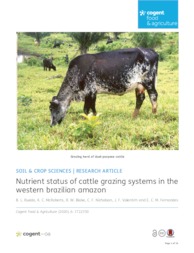Nutrient status of cattle grazing systems in the western brazilian Amazon.
Nutrient status of cattle grazing systems in the western brazilian Amazon.
Author(s): RUEDA, B. L.; McROBERTS, K. C.; BLAKE, R. W.; NICHOLSON, C. F.; VALENTIM, J. F.; FERNANDES, E. C. M.
Summary: Low-input cultivated pastures to feed cattle have dominated land use after forest clearing for decades in the western Brazilian Amazon. This study was undertaken to help understand the inherent nutrient supply dynamics underwriting cattle performance on three farms in the state of Acre. We assessed soil chemical and physical properties associated over time with different land uses following forest clearing. This information permitted specifying a conceptual model of nutrient stocks and flows under the observed grazing system, which produced insights about the dynamics of soil nutrient degradation. Above ground forage mass, topsoil nutrient concentrations and soil bulk density were measured. Land covers were Brachiaria spp. grasses, a grass-Pueraria phaseoloides mix, cropland and forest. Most soil nutrient parameters initially decreased after clearing, gradually recovering over time with grass-only pastures; however, 20 yr-old pastures had 20% less forage mass. Most pasture system nutrients on these farms resided in topsoil and roots, where large stocks of mature forage supported soil fertility with recycled nutrients from litter. Estimates of partial topsoil nutrient balances were negative. This suggested that corresponding nutrient stocks and the accumulation of forage mass were probably maintained primarily through the sum of inflows from cattle excreta, the subsoil, soil organic matter, and litter mineralization with scant input of commercial fertilizer. Therefore, herd management to increase animal system productivity via higher stocking rates on vegetatively younger forage requires monitoring of nutrient stocks and flows and fertilization that assures replenishment of the nutrients extracted. Otherwise, rapid depletion of soil nutrient stocks will lead to system degradation and failure.
Publication year: 2020
Types of publication: Journal article
Unit: Embrapa Acre
Observation
Some of Embrapa's publications are published as ePub files. To read them, use or download one of the following free software options to your computer or mobile device. Android: Google Play Books; IOS: iBooks; Windows and Linux: Calibre.
Access other publications
Access the Agricultural Research Database (BDPA) to consult Embrapa's full library collection and records.
Visit Embrapa Bookstore to purchase books and other publications sold by Embrapa.

